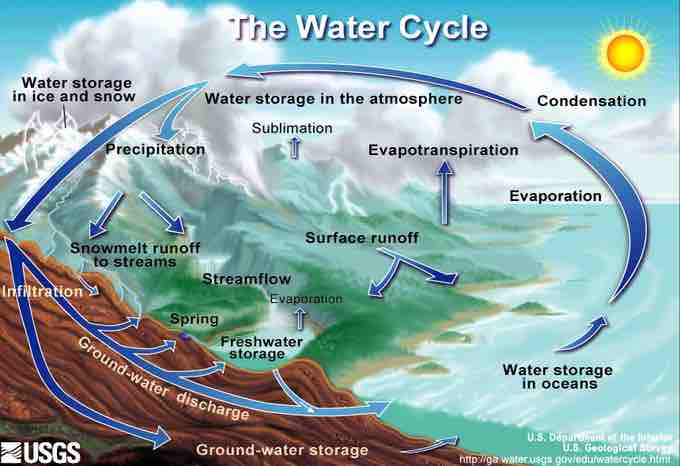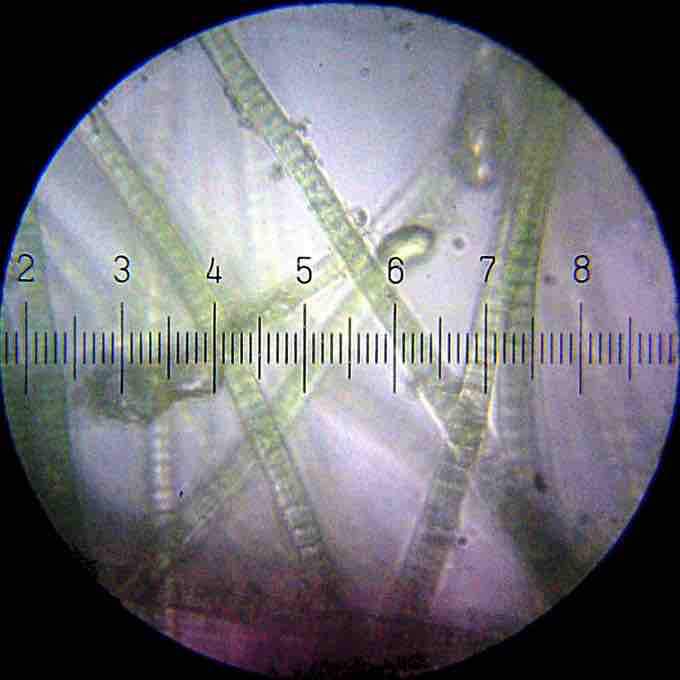Microbial Role in Biogeochemical Cycling
Nutrients move through the ecosystem in biogeochemical cycles. A biogeochemical cycle is a pathway by which a chemical element (such as carbon or nitrogen) circulates through the biotic (living) and the abiotic (non-living) factors of an ecosystem. The elements that move through the factors of an ecosystem are not lost but are instead recycled or accumulated in places called reservoirs (or "sinks") where they can be held for a long period of time. Elements, chemical compounds, and other forms of matter are passed from one organism to another and from one part of the biosphere to another through these biogeochemical cycles.
Ecosystems have many biogeochemical cycles operating as a part of the system. A good example of a molecule that is cycled within an ecosystem is water, which is always recycled through the water cycle. Water undergoes evaporation, condensation, and then falls back to Earth as rain (or other forms of precipitation). This typifies the cycling that is observed for all of the principal elements of life .

The Water Cycle
Water is recycled in an ecosystem through the water cycle.
Although biogeochemical cycles in a given ecosystem are coordinated by the full complement of living organisms and abiotic factors that make up that system, microorganisms play a primary role in regulating biogeochemical systems in virtually all of our planet's environments. This includes extreme environments such as acid lakes and hydrothermal vents, and even includes living systems such as the human gut. The key collective metabolic processes of microbes (including nitrogen fixation, carbon fixation, methane metabolism, and sulfur metabolism) effectively control global biogeochemical cycling. Incredibly, production by microbes is so immense that global biogeochemistry would likely not change even if eukaryotic life were totally absent!
Microbes comprise the backbone of every ecological system, particularly those in which there is no light (i.e. systems in which energy cannot be collected through photosynthesis). Two key examples of critical biogeochemical processes carried out by microorganisms are discussed below.
The Carbon Cycle
Carbon is critical for life because it is the essential building block of all organic compounds. Plants and animals utilize carbon to produce carbohydrates, fats, and proteins, which can then be used to build their internal structures or to obtain energy.
Carbon in the form of carbon dioxide (CO2) is readily obtained from the atmosphere, but before it can be incorporated into living organisms it must be transformed into a usable organic form. The transformative process by which carbon dioxide is taken up from the atmospheric reservoir and "fixed" into organic substances is called carbon fixation. Perhaps the best known example of carbon fixation is photosynthesis, a process by which energy derived from sunlight is harnessed to form organic compounds. Photosynthesis depends on the activity of microorganisms such as cyanobacteria; indeed, the fact that there is oxygen in the Earth's atmosphere at all is a consequence of the photosynthetic activity of ancient microbes .

Cyanobacteria
Cyanobacteria, also known as blue-green bacteria, blue-green algae, and Cyanophyta, is a phylum of bacteria that obtain their energy through photosynthesis
The Nitrogen Cycle
Nitrogen is essential for all forms of life because it is required for synthesis of the basic building blocks of life (e.g., DNA, RNA, and amino acids). The Earth's atmosphere is primarily composed of nitrogen, but atmospheric nitrogen (N2) is relatively unusable for biological organisms. Consequently, chemical processing of nitrogen (or nitrogen fixation) is necessary to convert gaseous nitrogen into forms that living organisms can use. Almost all of the nitrogen fixation that occurs on the planet is carried out by bacteria that have the enzyme nitrogenase, which combines N2 with hydrogen to produce a useful form of nitrogen (such as ammonia). Thus, microorganisms are absolutely essential for plant and animal life forms, which cannot fix nitrogen on their own .

The Role of Microbes in the Nitrogen Cycle
The processing of nitrogen into a biologically useful form requires the activity of microorganisms.